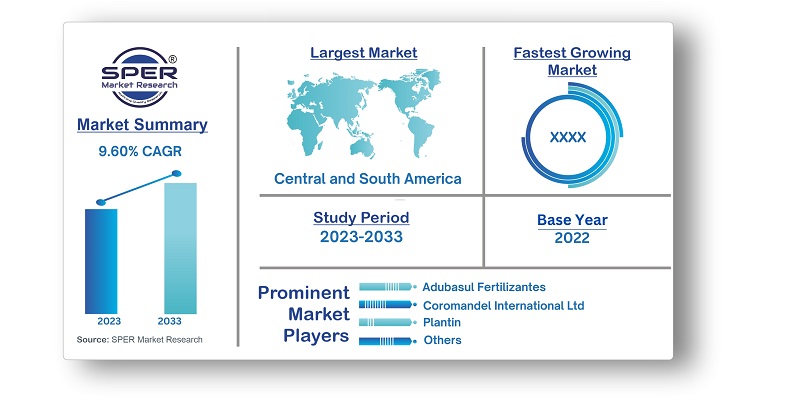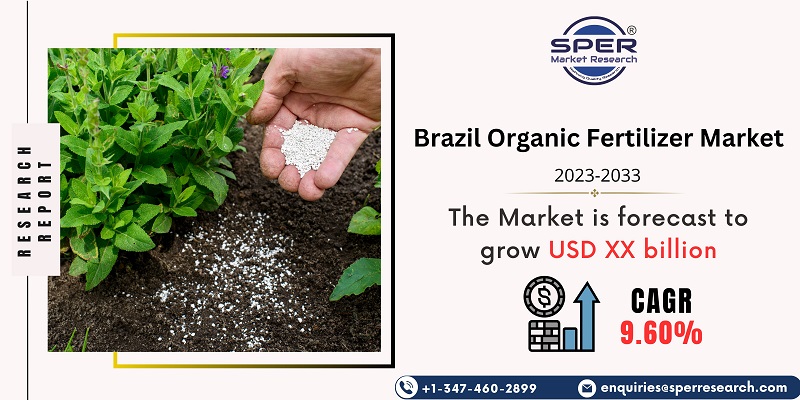
Brazil Organic Fertilizer Market Growth, Size, Trends, Demand, Revenue, Share and Future Outlook
Brazil Organic Fertilizer Market Size- By Form, By Crop Type- Regional Outlook, Competitive Strategies and Segment Forecast to 2033
| Published: Sep-2023 | Report ID: AGRI2342 | Pages: 1 - 104 | Formats*: |
| Category : Agriculture | |||
- Coromandel International Ltd approved the merger of Coromandel SQM (India) Private Limited (CSQM), a wholly owned subsidiary, and Liberty Pesticides and Fertilizers Limited (LPFL), with effect from April 1, 2021. It is hoped that this acquisition will enable the company to offer more products, including organic fertilizers.
- Coromandel International Ltd. introduced "Godavari BhuBhagya," an organic manure that has been bio-enhanced.


| Report Metric | Details |
| Market size available for years | 2019-2033 |
| Base year considered | 2022 |
| Forecast period | 2023-2033 |
| Segments covered | By Form, By Crop Type |
| Regions covered | Eastern Region, Southern Region, Western Region, Northern Region |
| Companies Covered | Adubasul Fertilizantes, Coromandel International Ltd, Plantin, Sigma Agriscience LLC, T.Stanes and Company Limited, Others |
- Farmers
- Agricultural Retailers and Distributors
- Agricultural Cooperatives
- Government Agencies
- Fertilizer Manufacturers and Suppliers
- Research Institutions and Agricultural Extension Services
- Environmental Organizations
| By Equipment Type: |
|
| By Crop Type: |
|
- Brazil Organic Fertilizer Market Size (FY’2023-FY’2033)
- Overview of Brazil Organic Fertilizer Market
- Segmentation of Brazil Organic Fertilizer Market By Form (Manure, Meal Based Fertilizers, Oilcakes, Others)
- Segmentation of Brazil Organic Fertilizer Market By Crop Type (Cash Crops, Horticulture Crops, Row Crops)
- Statistical Snap of Brazil Organic Fertilizer Market
- Expansion Analysis of Brazil Organic Fertilizer Market
- Problems and Obstacles in Brazil Organic Fertilizer Market
- Competitive Landscape in the Brazil Organic Fertilizer Market
- Impact of COVID-19 and Demonetization on Brazil Organic Fertilizer Market
- Details on Current Investment in Brazil Organic Fertilizer Market
- Competitive Analysis of Brazil Organic Fertilizer Market
- Prominent Players in the Brazil Organic Fertilizer Market
- SWOT Analysis of Brazil Organic Fertilizer Market
- Brazil Organic Fertilizer Market Future Outlook and Projections (FY’2023-FY’2033)
- Recommendations from Analyst
1.1. Scope of the report1.2. Market segment analysis
2.1. Research data source2.1.1. Secondary Data2.1.2. Primary Data2.1.3. SPER’s internal database2.1.4. Premium insight from KOL’s2.2. Market size estimation2.2.1. Top-down and Bottom-up approach2.3. Data triangulation
4.1. Driver, Restraint, Opportunity and Challenges analysis4.1.1. Drivers4.1.2. Restraints4.1.3. Opportunities4.1.4. Challenges4.2. COVID-19 Impacts of the Brazil Organic Fertilizer Market
5.1. SWOT Analysis5.1.1. Strengths5.1.2. Weaknesses5.1.3. Opportunities5.1.4. Threats5.2. PESTEL Analysis5.2.1. Political Landscape5.2.2. Economic Landscape5.2.3. Social Landscape5.2.4. Technological Landscape5.2.5. Environmental Landscape5.2.6. Legal Landscape5.3. PORTER’s Five Forces5.3.1. Bargaining power of suppliers5.3.2. Bargaining power of buyers5.3.3. Threat of Substitute5.3.4. Threat of new entrant5.3.5. Competitive rivalry5.4. Heat Map Analysis
6.1. Brazil Organic Fertilizer Market Manufacturing Base Distribution, Sales Area, Product Type6.2. Mergers & Acquisitions, Partnerships, Product Launch, and Collaboration in Brazil Organic Fertilizer Market
7.1. Brazil Organic Fertilizer Market Value Share and Forecast, By Form, 2023-20337.2. Manure7.3. Meal Based Fertilizers7.4. Oilcakes7.5. Others
8.1. Brazil Organic Fertilizer Market Value Share and Forecast, By Crop Type, 2023-20338.2. Cash Crops8.3. Hortilculture Crops8.4. Row Crops
9.1. Brazil Organic Fertilizer Market Size and Market Share
10.1. Brazil Organic Fertilizer Market Size and Market Share By Form (2019-2026)10.2. Brazil Organic Fertilizer Market Size and Market Share By Form (2027-2033)
11.1. Brazil Organic Fertilizer Market Size and Market Share By Crop Type (2019-2026)11.2. Brazil Organic Fertilizer Market Size and Market Share By Crop Type (2027-2033)
12.1. Brazil Organic Fertilizer Market Size and Market Share By Region (2019-2026)12.2. Brazil Organic Fertilizer Market Size and Market Share By Region (2027-2033)12.3. Eastern Region12.4. Southern Region12.5. Western Region12.6. Norther Region
13.1. Adubasul Fertilizantes13.1.1. Company details13.1.2. Financial outlook13.1.3. Product summary13.1.4. Recent developments13.2. Coromandel International Ltd13.2.1. Company details13.2.2. Financial outlook13.2.3. Product summary13.2.4. Recent developments13.3. Plantin13.3.1. Company details13.3.2. Financial outlook13.3.3. Product summary13.3.4. Recent developments13.4. Sigma AgriScience LLC13.4.1. Company details13.4.2. Financial outlook13.4.3. Product summary13.4.4. Recent developments13.5. T.Stanes and Company Limited13.5.1. Company details13.5.2. Financial outlook13.5.3. Product summary13.5.4. Recent developments13.6. Others
SPER Market Research’s methodology uses great emphasis on primary research to ensure that the market intelligence insights are up to date, reliable and accurate. Primary interviews are done with players involved in each phase of a supply chain to analyze the market forecasting. The secondary research method is used to help you fully understand how the future markets and the spending patterns look likes.
The report is based on in-depth qualitative and quantitative analysis of the Product Market. The quantitative analysis involves the application of various projection and sampling techniques. The qualitative analysis involves primary interviews, surveys, and vendor briefings. The data gathered as a result of these processes are validated through experts opinion. Our research methodology entails an ideal mixture of primary and secondary initiatives.



Frequently Asked Questions About This Report
PLACE AN ORDER
Year End Discount
Sample Report
Pre-Purchase Inquiry
NEED CUSTOMIZATION?
Request CustomizationCALL OR EMAIL US
100% Secure Payment






Related Reports
Our Global Clients
Our data-driven insights have influenced the strategy of 200+ reputed companies across the globe.






















